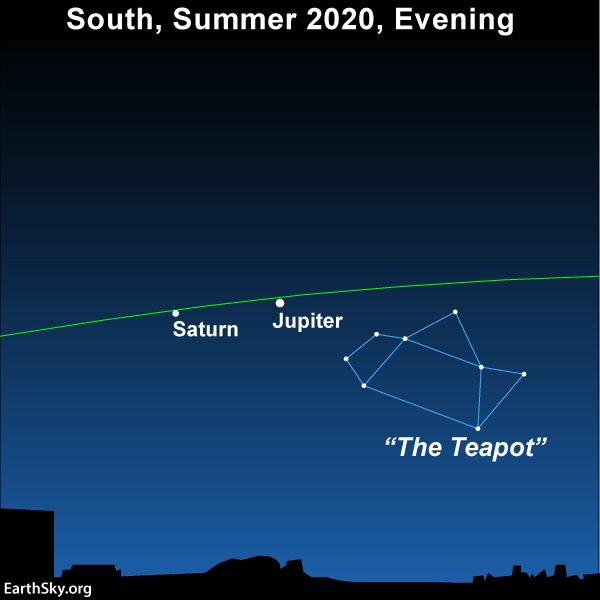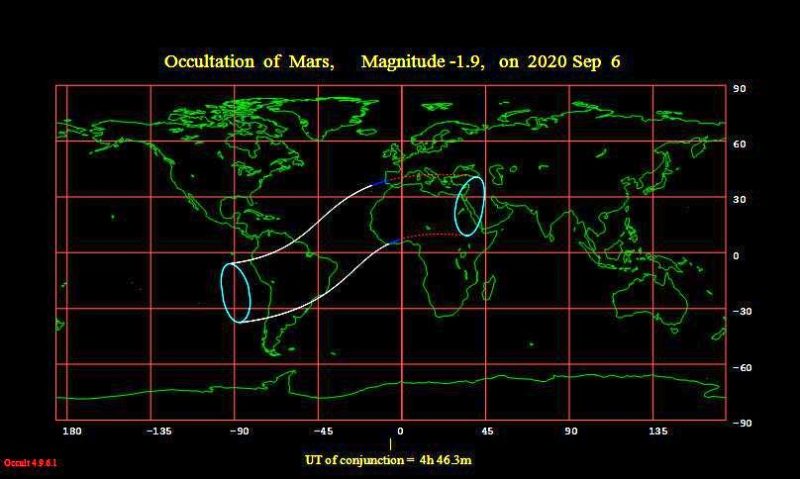
Mars is the planet to watch this month and next! Earth will pass between Mars and the sun in October, and the planet is now very bright and very red. Don’t miss the moon’s sweep past the Red Planet around September 4, 5 and 6, 2020. The moon can help you identify Mars now so that you can enjoy it in the weeks to come.
For a month or so – centered around mid-October 2020 – Mars will be even brighter than Jupiter. Currently, Mars is the 5th-brightest celestial object to light up the sky, after the sun, moon, Venus and Jupiter, respectively. However, Mars is brightening by the day, and by late September, will match Jupiter in brilliance. When Mars shines at its brightest for the year – in mid-October – it’ll be some 1 1/3 times brighter than Jupiter.
Around September 4-6, 2020, the moon is in waning gibbous phase. The moon and red planet Mars rise into your eastern sky several hours after sunset. They should be up by mid-evening, by around 9 to 10 p.m. local time, the time on your clock no matter where you are on the globe. If you have an obstructed eastern horizon, it could be a little later. Once they’re up, these two worlds will be out for rest of the night. Want a specific view from your location? Try Stellarium.
For the fun of it, we show Uranus on the chart above, too. It’s theoretically visible to the eye, but requires a very dark sky – and no nearby moon – to be seen. Click here for a chart showing Uranus’ location in front of the stars. You probably won’t see this faint and distant planet without an optical aid. People with good vision, and a good knowledge of Uranus’ place in the heavens, can spot Uranus as a dim speck of light on a dark, moonless night.
And – by the way – there are two bright planets in the sky as darkness falls. Neither one is Mars. These two are Jupiter and Saturn, with Jupiter being the brighter one; Jupiter is brighter than all the stars in the sky. Jupiter and Saturn are very noticeable now, headed for their great conjunction before 2020 ends. In a dark sky, you can see that Jupiter and Saturn are located near the grand sweep of the Milky Way, near the famous Teapot asterism in the constellation Sagittarius. See the chart below.

Jupiter and Saturn are both bright and noticeable for their nearness to each other. They climb highest up for the night around nightfall throughout September 2020.
Every month, as the moon journeys full circle in front of the constellations of the zodiac, the moon sweeps by every solar system planet.
As the moon makes it monthly rounds, the moon more often than not swings to the north or south of the planets. This month, however, the moon actually occults – goes directly in front of – Mars as seen from much of South America on the night of September 5-6, 2020. From North America, we’ll see the moon swing south of (or below) Mars; and from southern South America, folks will see the moon passing to the north of (and also below) Mars.
The chart below shows who can see this occultation of Mars.

Worldwide map of the lunar occultation of Mars on the night of September 5-6, 2020. The area in between the solid white sees the occultation in a nighttime sky, and the swath in between the dotted red lines has the occultation taking place in a daytime sky. Map via IOTA.
The occultation times are given at this IOTA (Internationa Occultation Timing Association) page in Universal Time (UTC), which you must covert to your local clock time. We give the occultation times in local time for Rio de Janeiro, Brazil (UTC-3 hours), and La Paz, Bolivia (UTC-4 hours):
Rio de Janeiro, Brazil
Occultation begins (Mars disappears behind the moon’s illuminated side): 12:15:33 a.m. local time September 6
Occulation ends (Mars reappears from behind the moon’s nighttime side): 12:35:28 a.m. local time September 6La Paz, Bolivia
Occultation begins (Mars disappears behind the moon’s illuminated side): 10:29:23 p.m. local time September 5
Occulation ends (Mars reappears from behind the moon’s nighttime side): 11:40:41 p.m. local time September 5
Bottom line: These next several nights – September 4, 5 and 6, 2020 – let the moon introduce you to the red planet Mars. We will pass between Mars and the sun in October 2020, when Mars will supplant Jupiter as the sky’s 4th-brightest heavenly body.
from EarthSky https://ift.tt/3jJz0C1

Mars is the planet to watch this month and next! Earth will pass between Mars and the sun in October, and the planet is now very bright and very red. Don’t miss the moon’s sweep past the Red Planet around September 4, 5 and 6, 2020. The moon can help you identify Mars now so that you can enjoy it in the weeks to come.
For a month or so – centered around mid-October 2020 – Mars will be even brighter than Jupiter. Currently, Mars is the 5th-brightest celestial object to light up the sky, after the sun, moon, Venus and Jupiter, respectively. However, Mars is brightening by the day, and by late September, will match Jupiter in brilliance. When Mars shines at its brightest for the year – in mid-October – it’ll be some 1 1/3 times brighter than Jupiter.
Around September 4-6, 2020, the moon is in waning gibbous phase. The moon and red planet Mars rise into your eastern sky several hours after sunset. They should be up by mid-evening, by around 9 to 10 p.m. local time, the time on your clock no matter where you are on the globe. If you have an obstructed eastern horizon, it could be a little later. Once they’re up, these two worlds will be out for rest of the night. Want a specific view from your location? Try Stellarium.
For the fun of it, we show Uranus on the chart above, too. It’s theoretically visible to the eye, but requires a very dark sky – and no nearby moon – to be seen. Click here for a chart showing Uranus’ location in front of the stars. You probably won’t see this faint and distant planet without an optical aid. People with good vision, and a good knowledge of Uranus’ place in the heavens, can spot Uranus as a dim speck of light on a dark, moonless night.
And – by the way – there are two bright planets in the sky as darkness falls. Neither one is Mars. These two are Jupiter and Saturn, with Jupiter being the brighter one; Jupiter is brighter than all the stars in the sky. Jupiter and Saturn are very noticeable now, headed for their great conjunction before 2020 ends. In a dark sky, you can see that Jupiter and Saturn are located near the grand sweep of the Milky Way, near the famous Teapot asterism in the constellation Sagittarius. See the chart below.

Jupiter and Saturn are both bright and noticeable for their nearness to each other. They climb highest up for the night around nightfall throughout September 2020.
Every month, as the moon journeys full circle in front of the constellations of the zodiac, the moon sweeps by every solar system planet.
As the moon makes it monthly rounds, the moon more often than not swings to the north or south of the planets. This month, however, the moon actually occults – goes directly in front of – Mars as seen from much of South America on the night of September 5-6, 2020. From North America, we’ll see the moon swing south of (or below) Mars; and from southern South America, folks will see the moon passing to the north of (and also below) Mars.
The chart below shows who can see this occultation of Mars.

Worldwide map of the lunar occultation of Mars on the night of September 5-6, 2020. The area in between the solid white sees the occultation in a nighttime sky, and the swath in between the dotted red lines has the occultation taking place in a daytime sky. Map via IOTA.
The occultation times are given at this IOTA (Internationa Occultation Timing Association) page in Universal Time (UTC), which you must covert to your local clock time. We give the occultation times in local time for Rio de Janeiro, Brazil (UTC-3 hours), and La Paz, Bolivia (UTC-4 hours):
Rio de Janeiro, Brazil
Occultation begins (Mars disappears behind the moon’s illuminated side): 12:15:33 a.m. local time September 6
Occulation ends (Mars reappears from behind the moon’s nighttime side): 12:35:28 a.m. local time September 6La Paz, Bolivia
Occultation begins (Mars disappears behind the moon’s illuminated side): 10:29:23 p.m. local time September 5
Occulation ends (Mars reappears from behind the moon’s nighttime side): 11:40:41 p.m. local time September 5
Bottom line: These next several nights – September 4, 5 and 6, 2020 – let the moon introduce you to the red planet Mars. We will pass between Mars and the sun in October 2020, when Mars will supplant Jupiter as the sky’s 4th-brightest heavenly body.
from EarthSky https://ift.tt/3jJz0C1

Aucun commentaire:
Enregistrer un commentaire